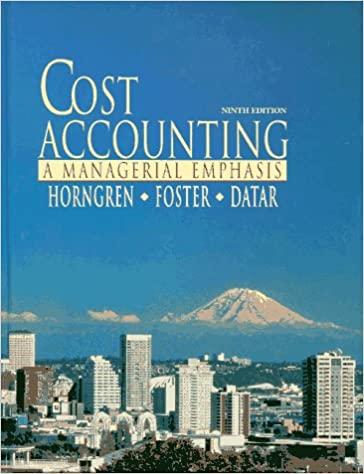Problem 9-23 Cash Budget with Supporting Schedules; Changing Assumptions [LO9-2, LO9-4, LO9-8] Garden Sales, Inc., sells garden supplies. Management is planning its cash needs for
Problem 9-23 Cash Budget with Supporting Schedules; Changing Assumptions [LO9-2, LO9-4, LO9-8]
Garden Sales, Inc., sells garden supplies. Management is planning its cash needs for the second quarter. The company usually has to borrow money during this quarter to support peak sales of lawn care equipment, which occur during May. The following information has been assembled to assist in preparing a cash budget for the quarter:
- Budgeted monthly absorption costing income statements for AprilJuly are:
| April | May | June | July | |||||||||
| Sales | $ | 660,000 | $ | 1,160,000 | $ | 620,000 | $ | 530,000 | ||||
| Cost of goods sold | 462,000 | 812,000 | 434,000 | 371,000 | ||||||||
| Gross margin | 198,000 | 348,000 | 186,000 | 159,000 | ||||||||
| Selling and administrative expenses: | ||||||||||||
| Selling expense | 123,000 | 111,000 | 73,000 | 53,000 | ||||||||
| Administrative expense* | 51,000 | 69,600 | 45,200 | 50,000 | ||||||||
| Total selling and administrative expenses | 174,000 | 180,600 | 118,200 | 103,000 | ||||||||
| Net operating income | $ | 24,000 | $ | 167,400 | $ | 67,800 | $ | 56,000 | ||||
|
| ||||||||||||
*Includes $34,000 of depreciation each month.
- Sales are 20% for cash and 80% on account.
- Sales on account are collected over a three-month period with 10% collected in the month of sale; 70% collected in the first month following the month of sale; and the remaining 20% collected in the second month following the month of sale. Februarys sales totaled $290,000, and Marchs sales totaled $305,000.
- Inventory purchases are paid for within 15 days. Therefore, 50% of a months inventory purchases are paid for in the month of purchase. The remaining 50% is paid in the following month. Accounts payable at March 31 for inventory purchases during March total $131,600.
- Each months ending inventory must equal 20% of the cost of the merchandise to be sold in the following month. The merchandise inventory at March 31 is $92,400.
- Dividends of $41,000 will be declared and paid in April.
- Land costing $49,000 will be purchased for cash in May.
- The cash balance at March 31 is $63,000; the company must maintain a cash balance of atleast $40,000 at the end of each month.
- The company has an agreement with a local bank that allows the company to borrow in increments of $1,000 at the beginning of each month, up to a total loan balance of $200,000. The interest rate on these loans is 1% per month and for simplicity we will assume that interest is not compounded. The company would, as far as it is able, repay the loan plus accumulated interest at the end of the quarter.
The companys president is interested in knowing how reducing inventory levels and collecting accounts receivable sooner will impact the cash budget. He revises the cash collection and ending inventory assumptions as follows:
1. Sales continue to be 20% for cash and 80% on credit. However, credit sales from April, May, and June are collected over a three-month period with 25% collected in the month of sale, 65% collected in the month following sale, and 10% in the second month following sale. Credit sales from February and March are collected during the second quarter using the collection percentages specified in the main section.
2. The company maintains its ending inventory levels for April, May, and June at 15% of the cost of merchandise to be sold in the following month. The merchandise inventory at March 31 remains $92,400 and accounts payable for inventory purchases at March 31 remains $131,600.

3. Using the president's new assumptions, prepare a cash budget for April, May, and June, and for the quarter in total. (Cash deficiency, repayments and interest should be indicated by a minus sign.) Garden Sales, Inc. Cash Budget For the Quarter Ended June 30 April May June Quarter Beginning cash balance 63,000 $ 63,000 Add collections from customers 402,000 743,200 928,800 2,074,000 Total cash available 465,000 743,200 928,800 2,137,000 Less cash disbursements: Purchases for inventory 316,400 634,200 594,300 1,544,900 Selling expenses 123,000 111,000 73,000 53,000 Administrative expenses 17,000 35,600 11,200 63,800 Land purchases 49,000 0 49,000 Dividends paid 41,000 0 0 41,000 Total cash disbursements 497,400 829,800 678,500 1,751,700 Excess deficiency) of cash available over disbursements (32,400) (86,600) 250,300 385,300 Financing Borrowings 160,000 Repayments 0 Interest 0 Total financing 160,000 Ending cash balance $ (32,400) $ (86,600) $ 250,300 $ 545,300 0 0
Step by Step Solution
There are 3 Steps involved in it
Step: 1

See step-by-step solutions with expert insights and AI powered tools for academic success
Step: 2

Step: 3

Ace Your Homework with AI
Get the answers you need in no time with our AI-driven, step-by-step assistance
Get Started


